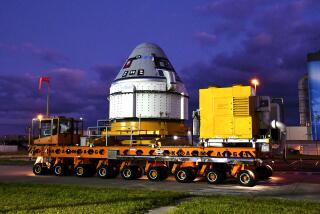NASA Prepares to Launch Hunt for Leaks on Shuttles
- Share via
WASHINGTON — Engineers on both coasts will begin tests after the Fourth of July to find the mysterious fuel leaks that have grounded America’s space shuttle fleet for an indefinite time.
A 17-inch fuel line removed from the shuttle Columbia was brought to shuttle builder Rockwell International Corp. in Downey, Calif., for the tests, along with the complicated hardware that connects the line to the orbiter and its huge fuel tank.
The shuttle Atlantis is still on the launch pad at the Kennedy Space Center in Florida, awaiting a sequence of tests being worked out this week. Both shuttles leaked super-cold liquid hydrogen as their tanks were being filled recently, causing their launches to be postponed.
“We don’t expect the stand-down to be extensive,” William Lenoir, NASA’s space flight chief, said Tuesday. But he conceded that, “We don’t know exactly how long it’s going to be.”
The shuttle fuel line tests in Downey will be conducted first with gaseous helium, then gaseous nitrogen, then gaseous hydrogen, Lenoir said. If that doesn’t reveal the leak, engineers will use liquid nitrogen and finally liquid hydrogen.
On NASA’s other big problem, the out-of-focus $1.5-billion Hubble Space Telescope, the space agency said that some fuzzy images may be improved through the same computer process that cleaned up photos taken by the Voyager spacecraft.
But, said Ed Weiler, a Hubble project scientist, the pictures will still be less clear than scientists originally expected.
Weiler said a team of experts was being selected to determine how much of the “fuzz ball” now being seen by the space telescope can be turned into crisp pictures through computer techniques.
He called the improvement of pictures through computers “something of a black art.” But he said other experts in the field are certain they can improve some of Hubble’s views.
“I’ll believe it when I see it,” Weiler told reporters. “We’ll let the experts play with the images. People in the field say there is a lot of hope there.”
Weiler emphasized, however, that the enhancing technique is only an effort to salvage some good from a fundamentally flawed telescope.
More to Read
Sign up for Essential California
The most important California stories and recommendations in your inbox every morning.
You may occasionally receive promotional content from the Los Angeles Times.













